Physical Address
304 North Cardinal St.
Dorchester Center, MA 02124
On completion of this chapter, you should be able to:
Describe the normal anatomy of the abdominal wall
List the peritoneal and retroperitoneal organs
Compare and contrast the different locations of fluid and their sonographic appearances
Discuss the pathology and sonographic findings of the peritoneal cavity, mesentery, omentum, peritoneum, and abdominal wall
The peritoneal cavity is comprised of multiple peritoneal ligaments and folds that connect the viscera to each other and the abdominopelvic walls. Within the cavity are the lesser and greater omentum , the mesenteries, the ligaments, and multiple fluid spaces (lesser sac, perihepatic and subphrenic spaces). The peritoneum is a smooth membrane that lines the entire abdominal cavity and is reflected over the contained organs. The section that lines the cavity walls is the parietal peritoneum , whereas the part covering the abdominal organs to a greater or lesser extent is the visceral peritoneum ( Fig. 14.1 ). In the male, the peritoneum forms a closed cavity; in the female, there is a “communication” outside the peritoneum through the uterine tubes, uterus, and vagina. In reality, however, the complex linings of the uterus and fallopian tubes tend to close off any potential space and prohibit the entrance of air into the peritoneal cavity.
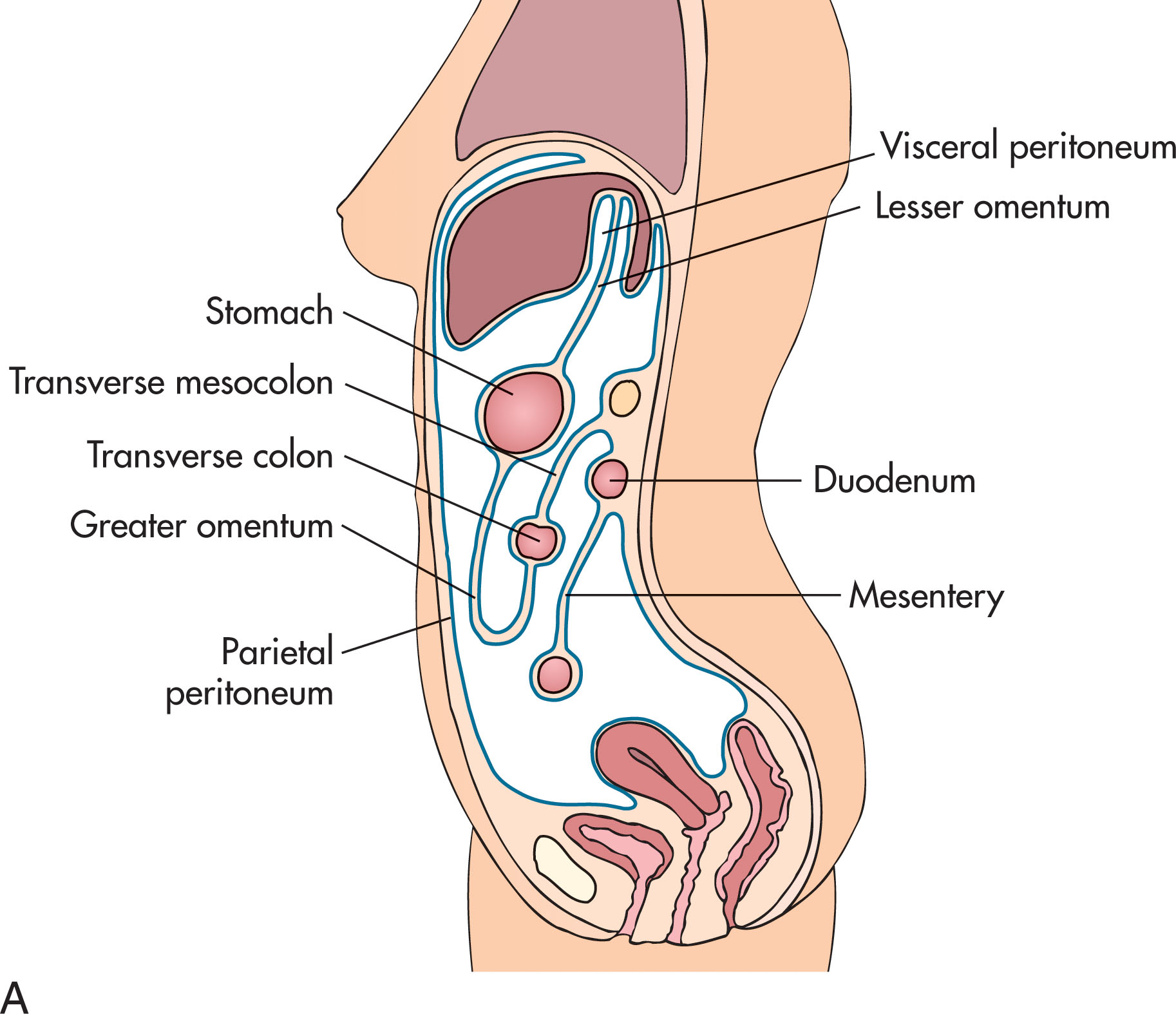
The relationship of the peritoneum to the abdominal structures may be understood with the visualization of an inflated balloon (the peritoneum) within an empty box (the abdominal cavity) ( Fig. 14.2 ). If one were to place objects within the box, yet outside the balloon, these objects might impinge on the balloon shape. This is the same condition that the kidneys and the ascending and descending colon have on the peritoneal cavity. Because these structures lie along the posterior surface of the peritoneal cavity, they are considered “retroperitoneal,” and they are overlaid by the visceral peritoneum. If an object bulges so far into the balloon that it loses contact with the box, the object will become surrounded by a fold of the balloon. This is the situation with the small intestine, transverse colon, and the sigmoid colon; they are suspended from the posterior abdominal wall by a double fold of peritoneum called the mesentery . Thus the peritoneal cavity is really empty of abdominal organs, as they bulge into or are covered by the cavity but are not located within the cavity.
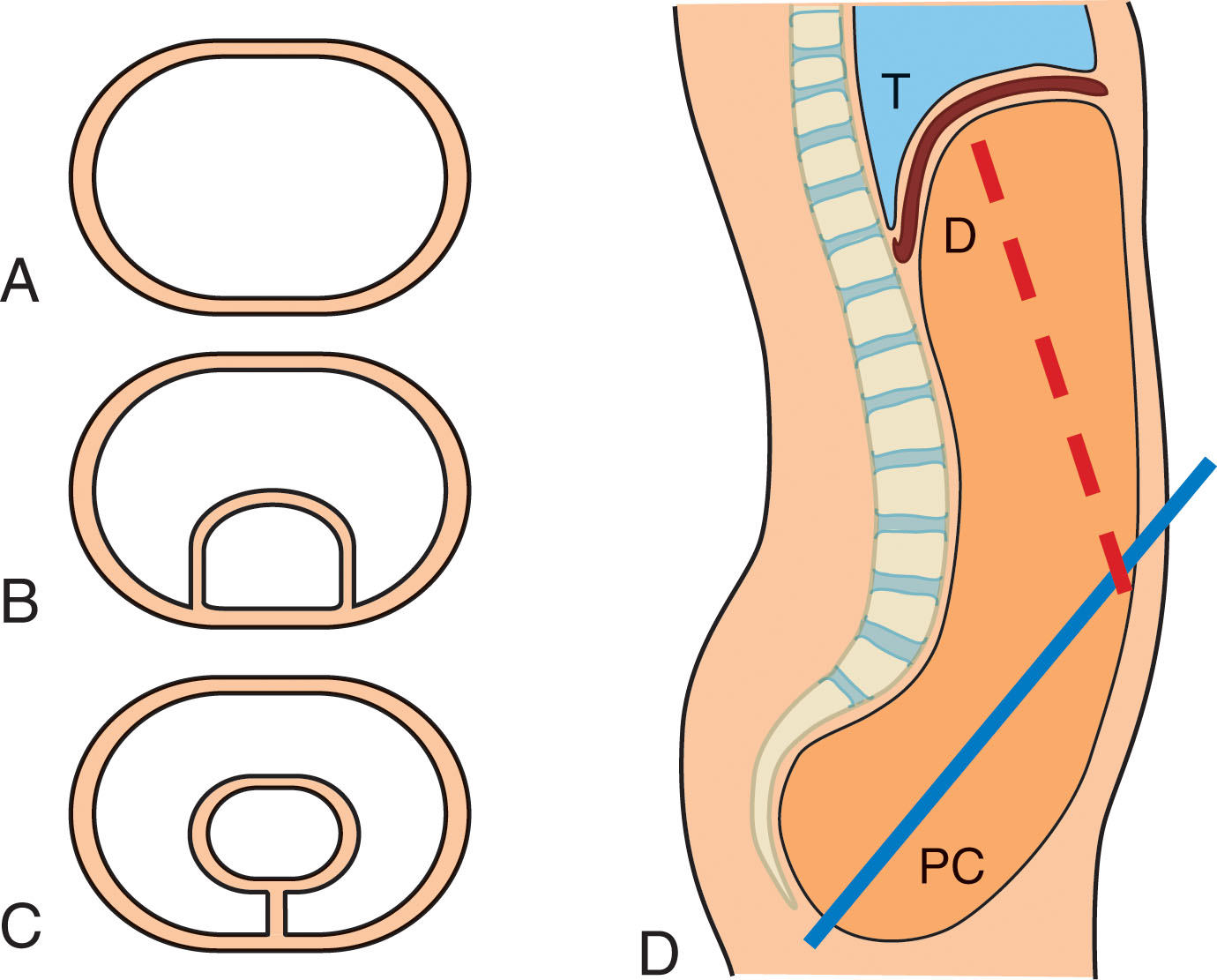
The general peritoneal cavity is known as the greater sac of the peritoneum. With the development of the stomach and the spleen, a smaller sac, called the lesser sac (omental bursa), is the peritoneal recess posterior to the stomach ( Fig. 14.3 ). This sac communicates with the greater sac through a small vertical opening known as the epiploic foramen. The epiploic foramen is just inferior to the liver and superior to the first part of the duodenum; the inferior vena cava is posterior, and the portal vein is anterior ( Fig. 14.4 ).
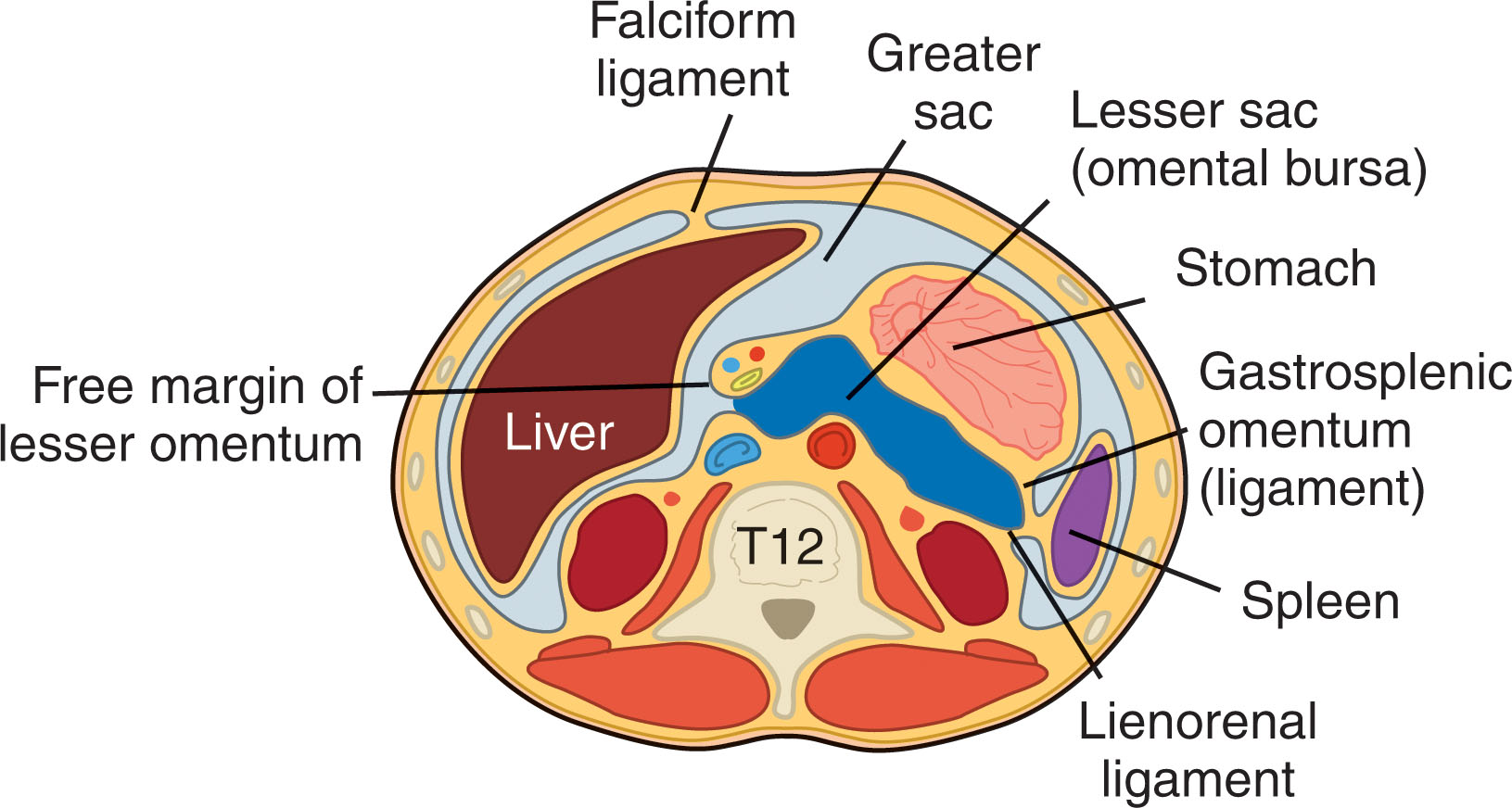
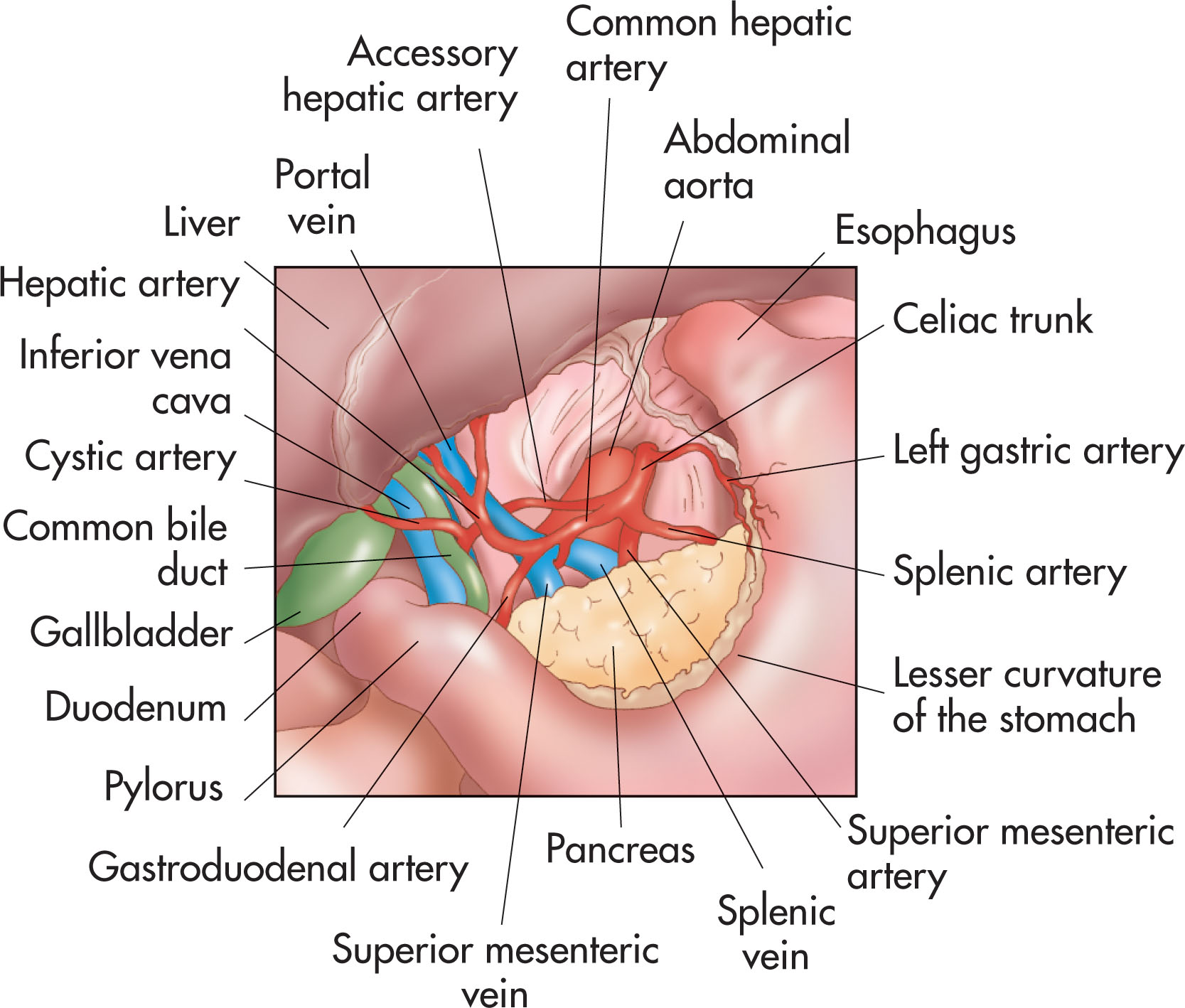
The attachments of the peritoneum to the abdominal walls and organs help determine the way abnormal collections of fluid within the peritoneal cavity can collect or move ( Fig. 14.5 ). When the patient is lying supine, the lowest part of the body is the pelvis. On a transverse view, the flanks are lower than the midabdomen. Fluid will accumulate in the lowest parts of the body; therefore, the pelvis and lateral flanks (gutters) should be carefully examined for pathologic collections of fluid.
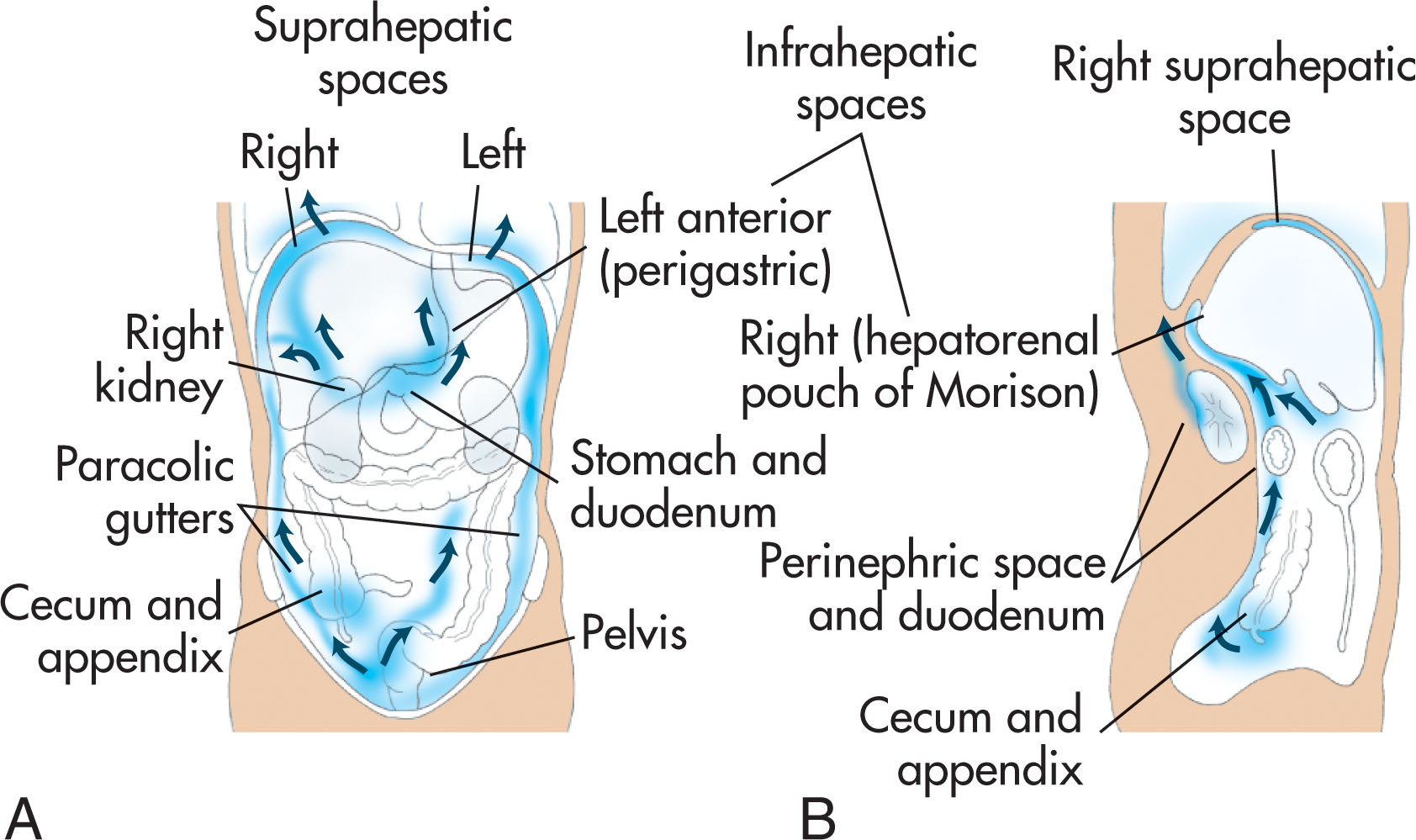
The lesser omentum is a double layer of peritoneum, extending from the liver to the lesser curvature of the stomach. This structure acts as a sling for the stomach, suspending it from the liver. ( Fig. 14.6 ).
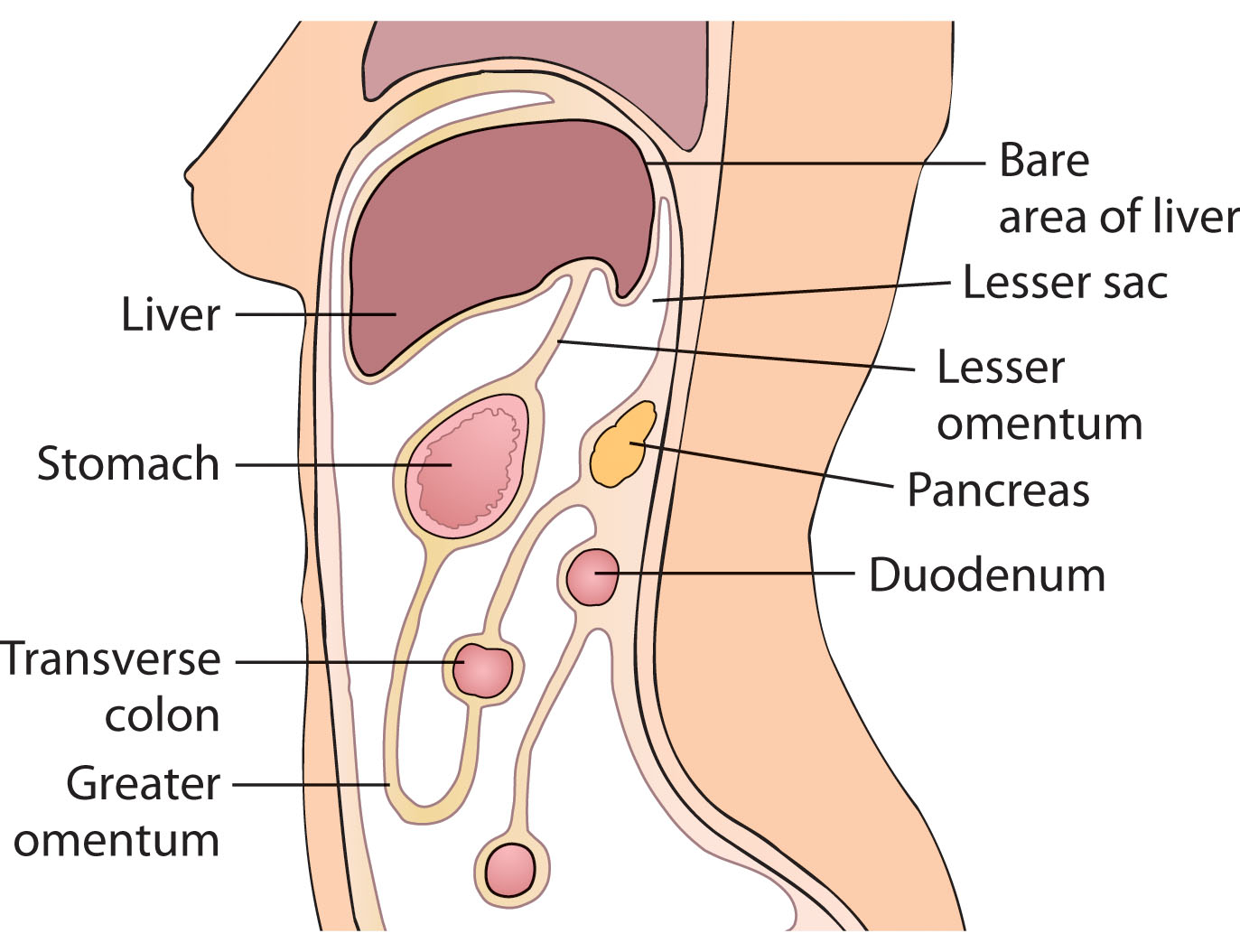
The greater omentum is an apron-like fold of the peritoneum that hangs from the greater curvature of the stomach ( Fig. 14.7 ). The omentum lies freely over the intestine except for the upper part, which is fused with the transverse colon and mesocolon. The greater omentum can adhere to diseased organs, which in turn helps prevent further spread of infected fluid by essentially “walling it off” from the rest of the body. The greater omentum is profusely supplied with blood vessels by the epiploic branches of the gastroepiploic vessels and thus can bring masses of blood phagocytes to the areas it adheres to, which in turn helps combat infection.
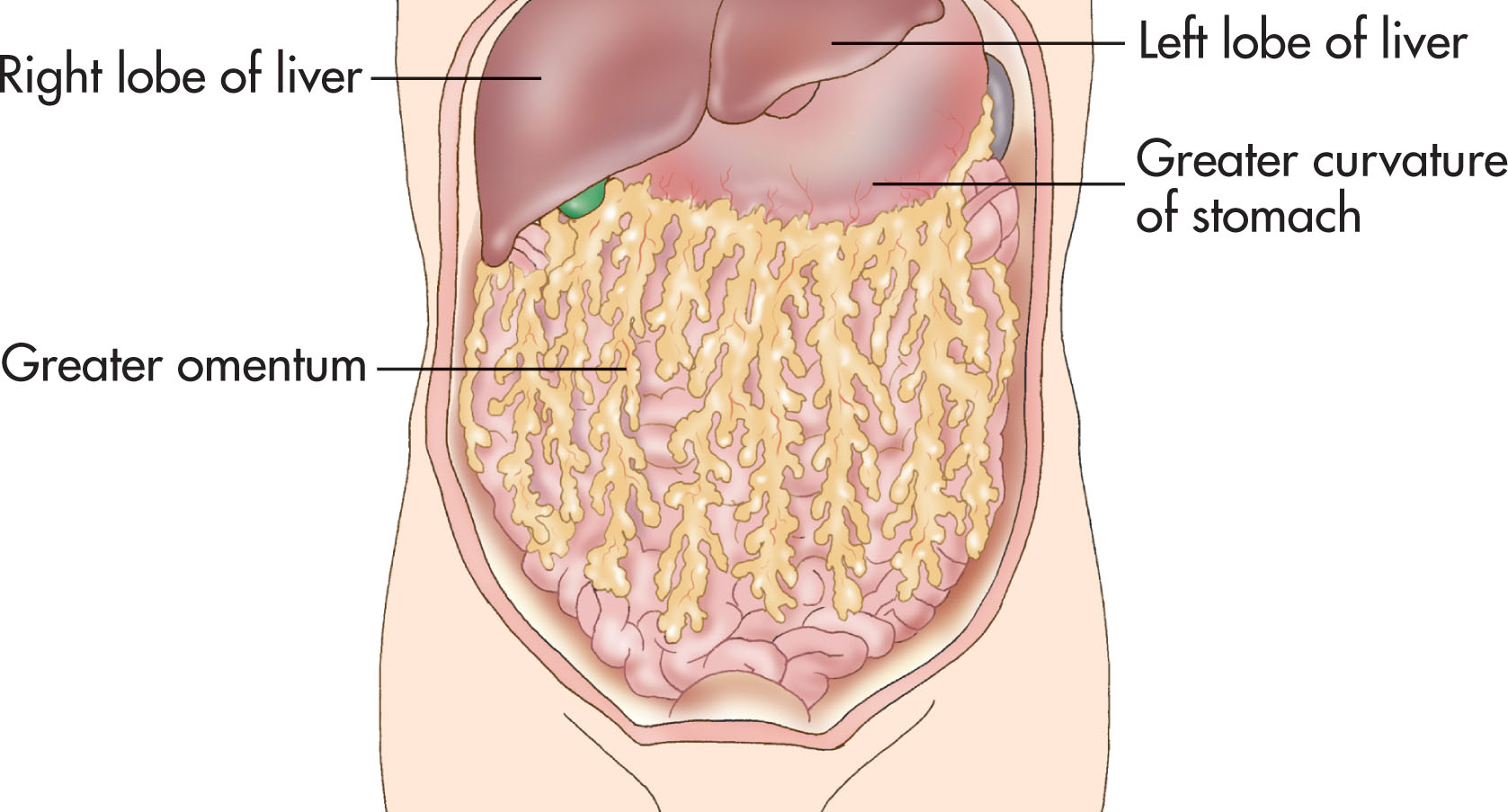
The determination of intraperitoneal fluid from pleural, subdiaphragmatic, subscapular, or retroperitoneal fluid is necessary to determine a differential diagnosis or to locate a fluid pocket for aspiration or a biopsy.
Because of the coronary ligament attachments, collections in the right posterior subphrenic space cannot extend between the bare area of the liver and the diaphragm. On the other hand, because the right pleural space extends medially to the attachment of the right superior coronary ligament, pleural collections may appear apposed to the bare area of the liver ( Fig. 14.8 ). Unless it is loculated, the pleural fluid tends to distribute posteromedially in the chest ( Fig. 14.9 ).
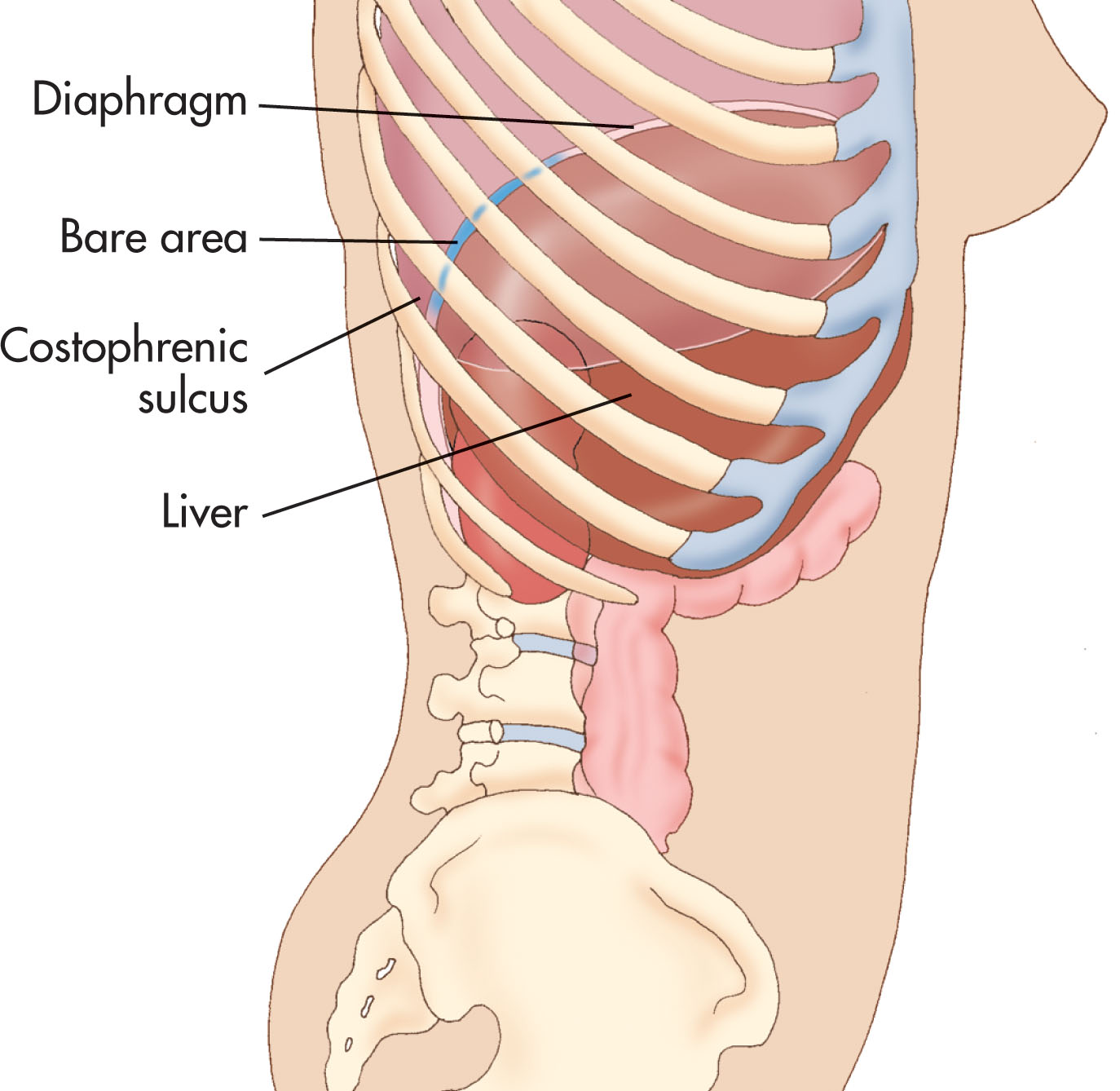
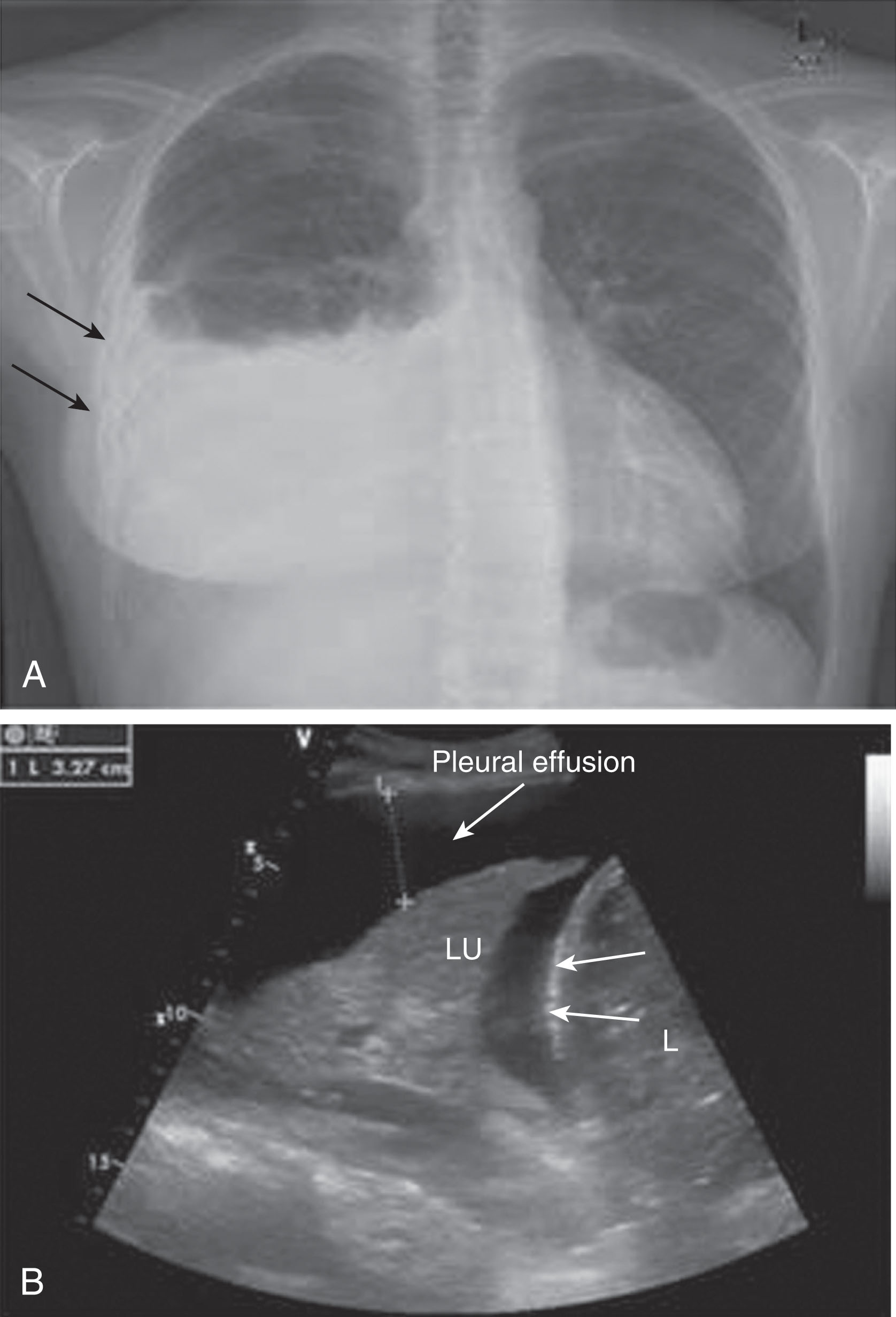
Subcapsular liver and splenic collections are seen when they are inferior to the diaphragm unilaterally, and they conform to the shape of an organ capsule ( Fig. 14.10 ). They may extend medially to the attachment of the superior coronary ligament.
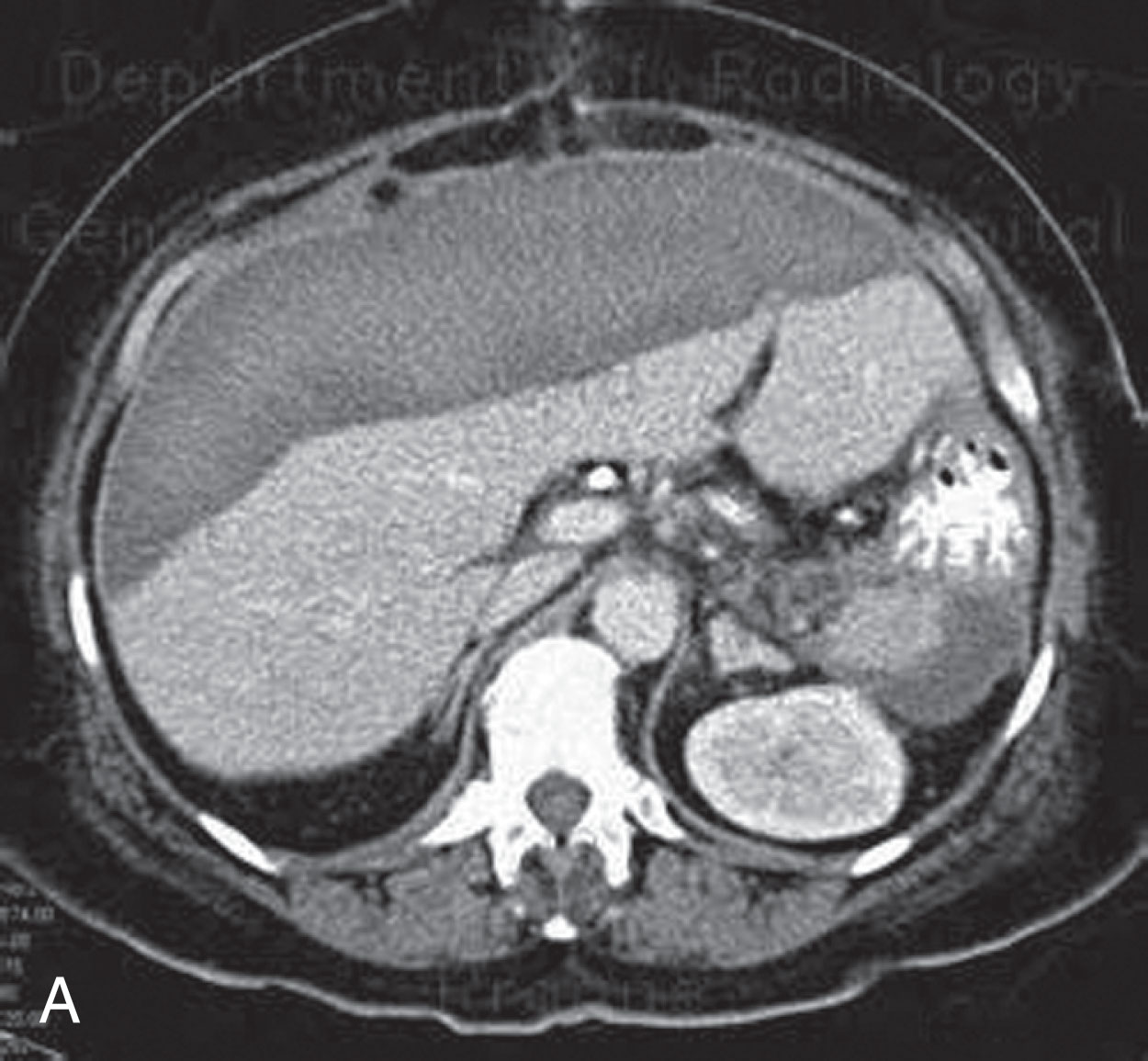
A mass is confirmed to be within the retroperitoneal cavity when anterior renal displacement or anterior displacement of the dilated ureters can be documented. The mass interposed anteriorly or superiorly to kidneys can be located either intraperitoneally or retroperitoneally ( Fig. 14.11 ).
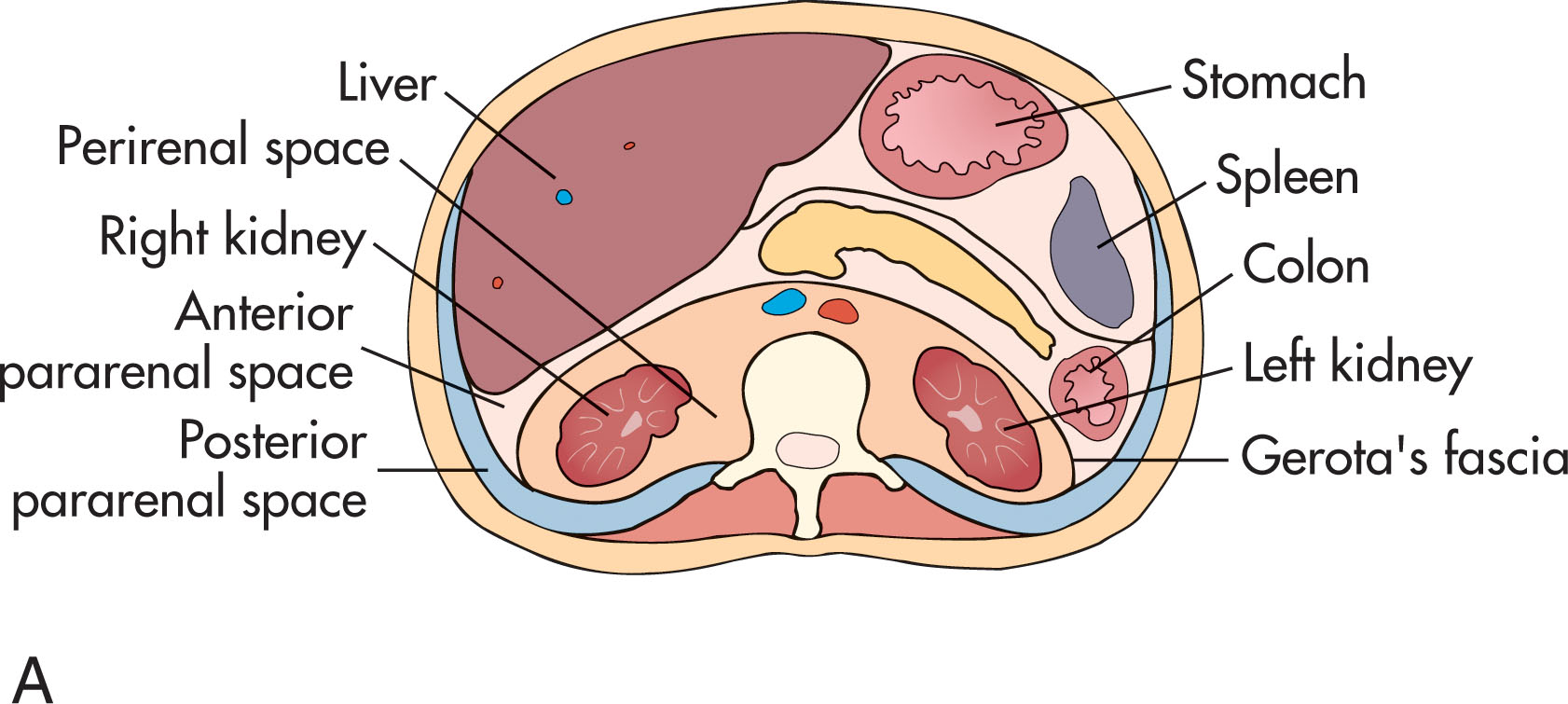
Fatty and collagenous connective tissues in the perirenal or anterior pararenal space produce echoes that are best demonstrated on sagittal scans. Retroperitoneal lesions displace echoes ventrally and cranially; hepatic and subhepatic lesions produce inferior and posterior displacement.
The anterior displacement of the superior mesenteric vessels, splenic vein, renal vein, and inferior vena cava excludes an intraperitoneal location. A large, right-sided retroperitoneal mass rotates the intrahepatic portal veins to the left. This causes the left portal vein to show reversed flow. Right posterior hepatic masses of similar dimensions may produce minor displacement of the intrahepatic portal vein. Primary liver masses should move simultaneously with the liver.
Ligaments on the right side of the liver form the subphrenic and subhepatic spaces . The falciform ligament divides the subphrenic space into right and left components. The ligamentum teres hepatis ascends from the umbilicus to the umbilical notch of the liver within the free margin of the falciform ligament before coursing within the liver ( Fig. 14.12 ).
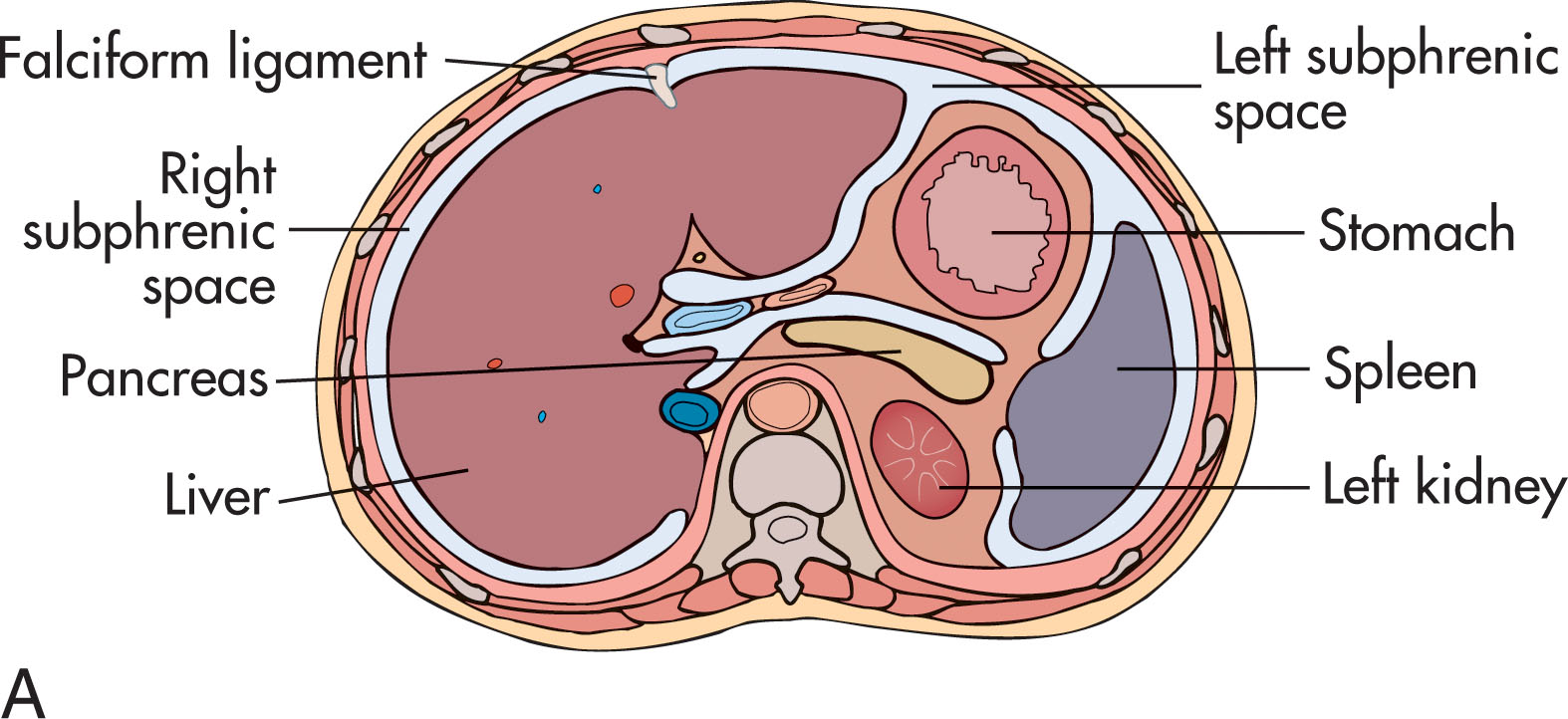
The bare area is delineated by the right superior and inferior coronary ligaments, which separate the posterior subphrenic space from the right superior subhepatic space (Morison’s pouch) . Lateral to the bare area and right triangular ligament, the posterior subphrenic and subhepatic spaces are continuous.
A single large and irregular perihepatic space surrounds the superior and lateral aspects of the left lobe of the liver, with the left coronary ligaments anatomically separating the subphrenic space into anterior and posterior compartments. The left subhepatic space is divided into an anterior compartment (the gastrohepatic recess) and a posterior compartment (the lesser sac) by the lesser omentum and stomach ( Fig. 14.13 ). The lesser sac lies anterior to the pancreas and posterior to the stomach. With fluid in the lesser and greater omental cavities, the lesser omentum may be seen as a linear, undulating echodensity extending from the stomach to the porta hepatis.
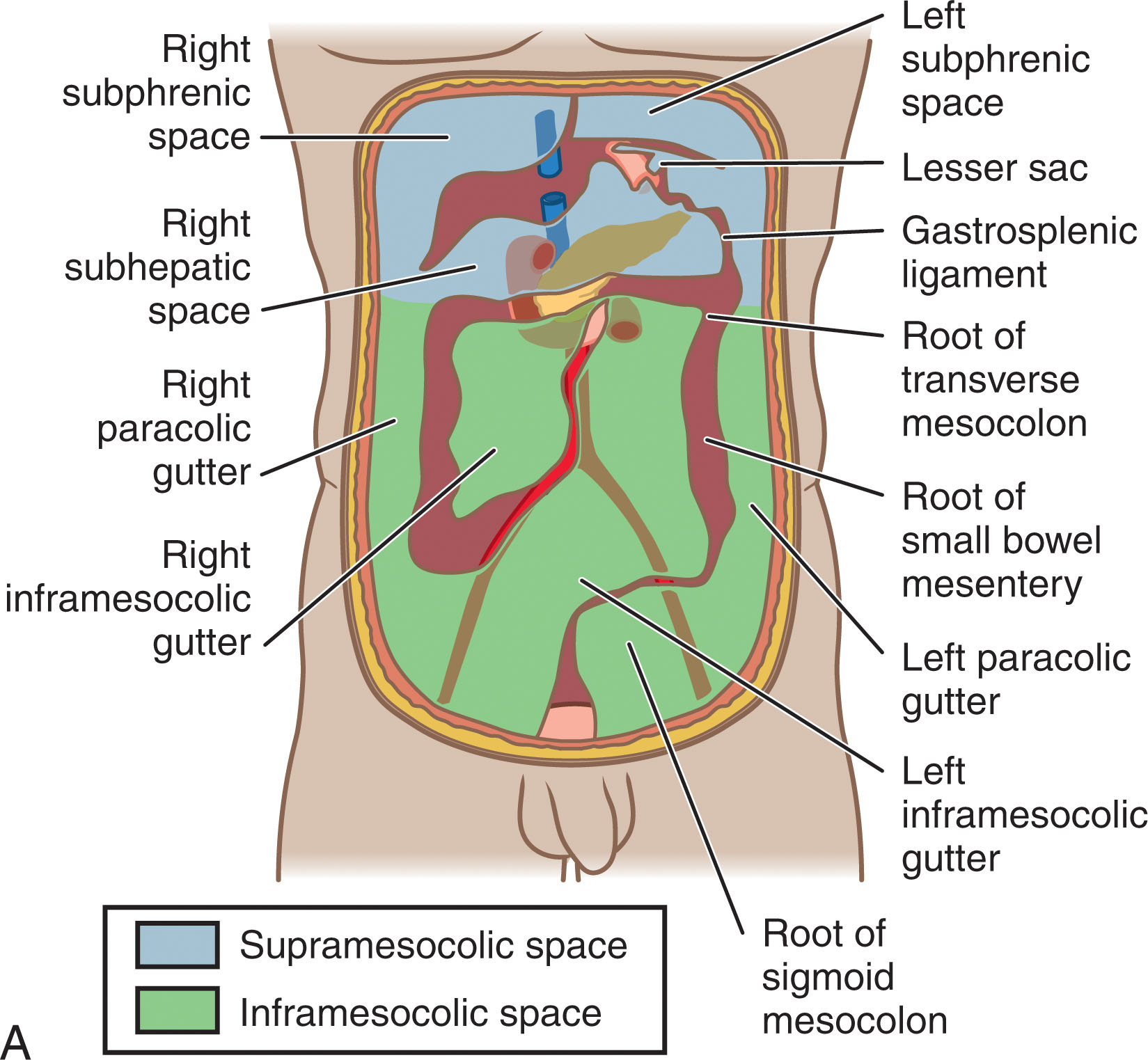
The gastrosplenic ligament is the left lateral extension of the greater omentum that connects the gastric greater curvature to the superior splenic hilum and forms a portion of the left lateral border of the lesser sac (see Fig. 14.12C ).
The splenorenal ligament is formed by the posterior reflection of the peritoneum of the spleen and passes inferiorly to overlie the left kidney (see Fig. 14.12C ). It forms the posterior portion of the left lateral border of the lesser sac and separates the lesser sac from the renosplenic recess.
The lesser omental bursa is subdivided into a larger lateroinferior and a smaller mediosuperior recess by the gastropancreatic folds, which are produced by the left gastric and hepatic arteries ( Fig. 14.14 ). The lesser sac extends to the diaphragm. The superior recess of the bursa surrounds the anterior, medial, and posterior surfaces of the caudate lobe, making the caudate a lesser sac structure. The lesser sac collections may extend a considerable distance below the plane of the pancreas by inferiorly displacing the transverse mesocolon or extending into the inferior recess of the greater omentum.
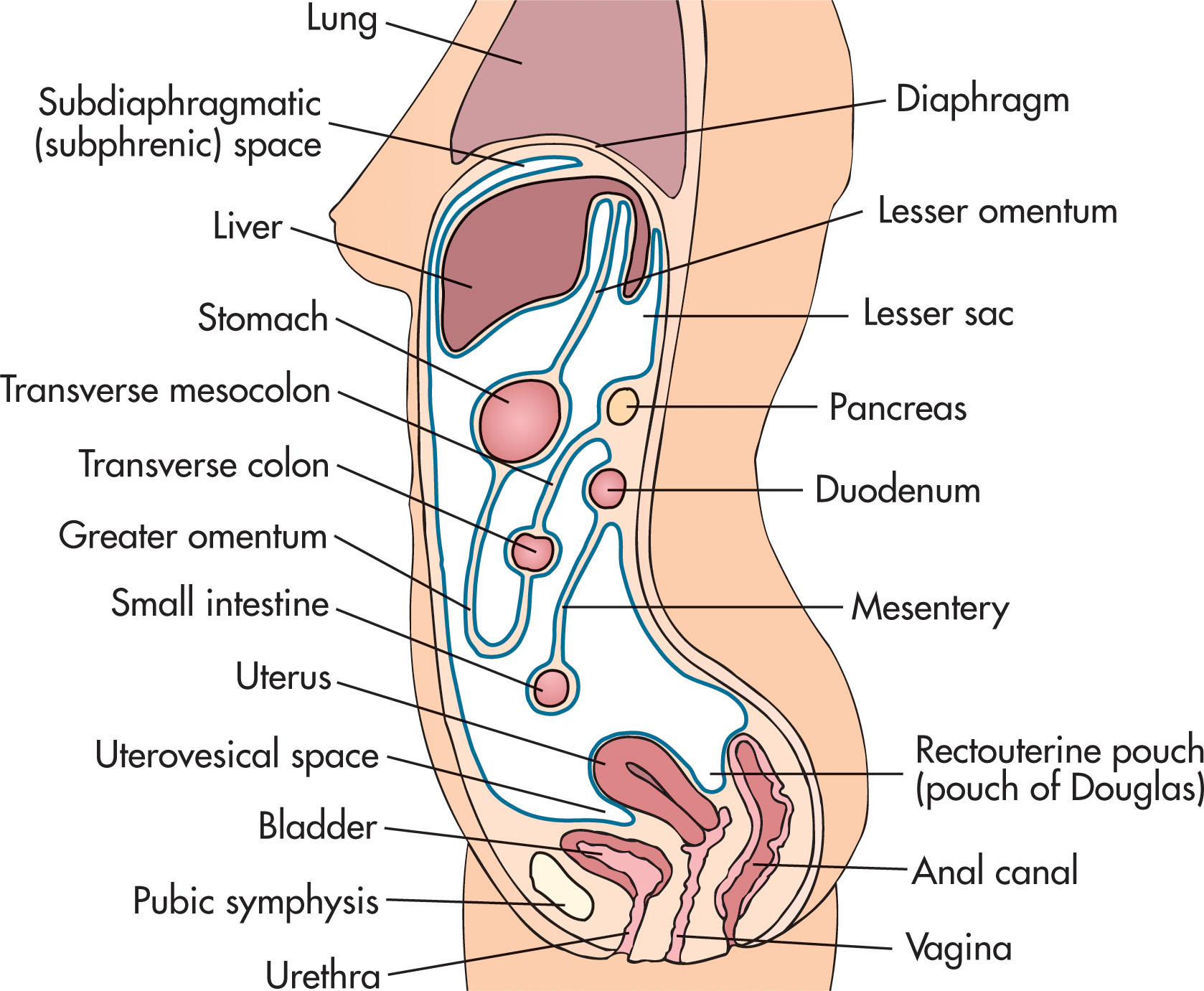
The supravesical space and the medial and lateral inguinal fossae represent intraperitoneal paravesical spaces formed by indentation of the anterior parietal peritoneum by the bladder, obliterated umbilical arteries, and inferior epigastric vessels. The retrovesical space is divided by the uterus into an anterior vesicouterine recess and a posterior rectouterine sac (pouch of Douglas) (see Fig. 14.14 ). The peritoneal reflection over the dome of the bladder may have an inferior recess extending anterior to the bladder. Ascites displaces the distended urinary bladder inferiorly but not posteriorly. Intraperitoneal fluid compresses the bladder from its lateral aspect in cases of loculation. Fluid in the extraperitoneal prevesical space has a “dumbbell” configuration, displacing the bladder posteriorly and compressing it from the sides along its entire length ( Fig. 14.15 ).
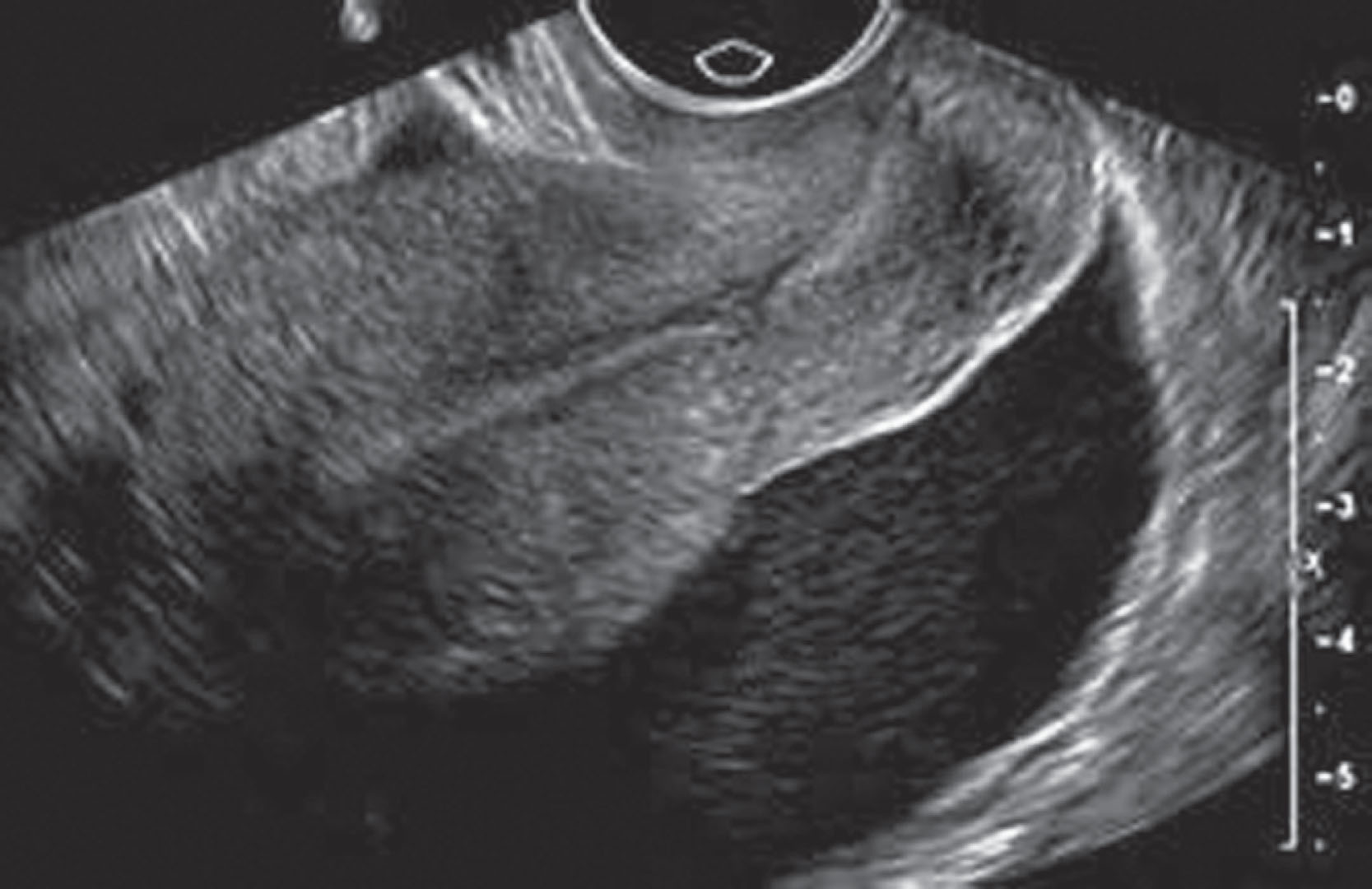
The paired rectus abdominis muscles are delineated medially in the midline of the body by the linea alba ( Fig. 14.16 ). Laterally the aponeuroses of external oblique, internal oblique, and transversus abdominis muscles unite to form a band-like vertical fibrous groove called the linea semilunaris or spigelian fascia. The sheath of the three anterolateral abdominal muscles invests the rectus both anteriorly and posteriorly. Midway between the umbilicus and symphysis pubis, the aponeurotic sheath passes anteriorly to the rectus.
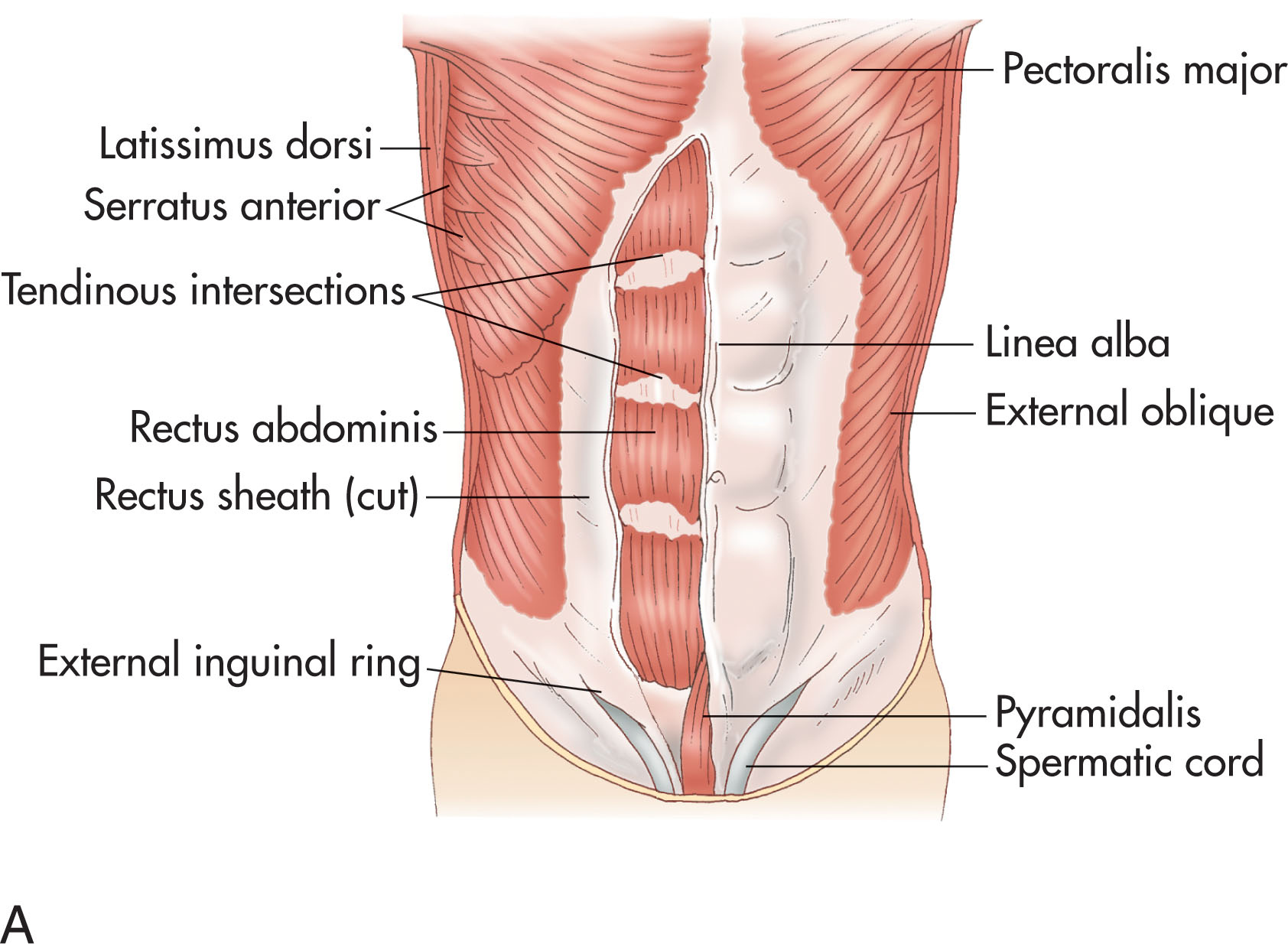
Below the peritoneal line, the rectus muscle is separated from the intraabdominal contents only by the transversalis fascia and the peritoneum. The rectus muscles are seen as a biconvex muscle group delineated by the linea alba and linea semilunaris. The peritoneal line is seen as a discrete linear echogenicity in the deepest layer of the abdominal wall.
Ascites is the accumulation of serous fluid in the peritoneal cavity. The amount of intraperitoneal fluid depends on the location, volume, and patient position. Factors other than fluid volume that affect the distribution of intraperitoneal fluid include peritoneal pressure, the area from which fluid originates, rapidity of fluid accumulation, presence or absence of adhesions, density of fluid with respect to other abdominal organs, and degree of bladder fullness.
Serous ascites appears as echo-free fluid regions indented and shaped by the organs and viscera it surrounds or between where it is interposed ( Fig. 14.17 ). The fluid first fills the pouch of Douglas, then the lateral paravesical recesses, before it ascends to both paracolic gutters. The major flow from the pelvis is via the right paracolic gutter. Small volumes of fluid in the supine patient first appear around the inferior tip of the right lobe in the superior portion of the right flank and in the pelvic cul-de-sac, then in the paracolic gutters, before moving lateral and anterior to the liver.
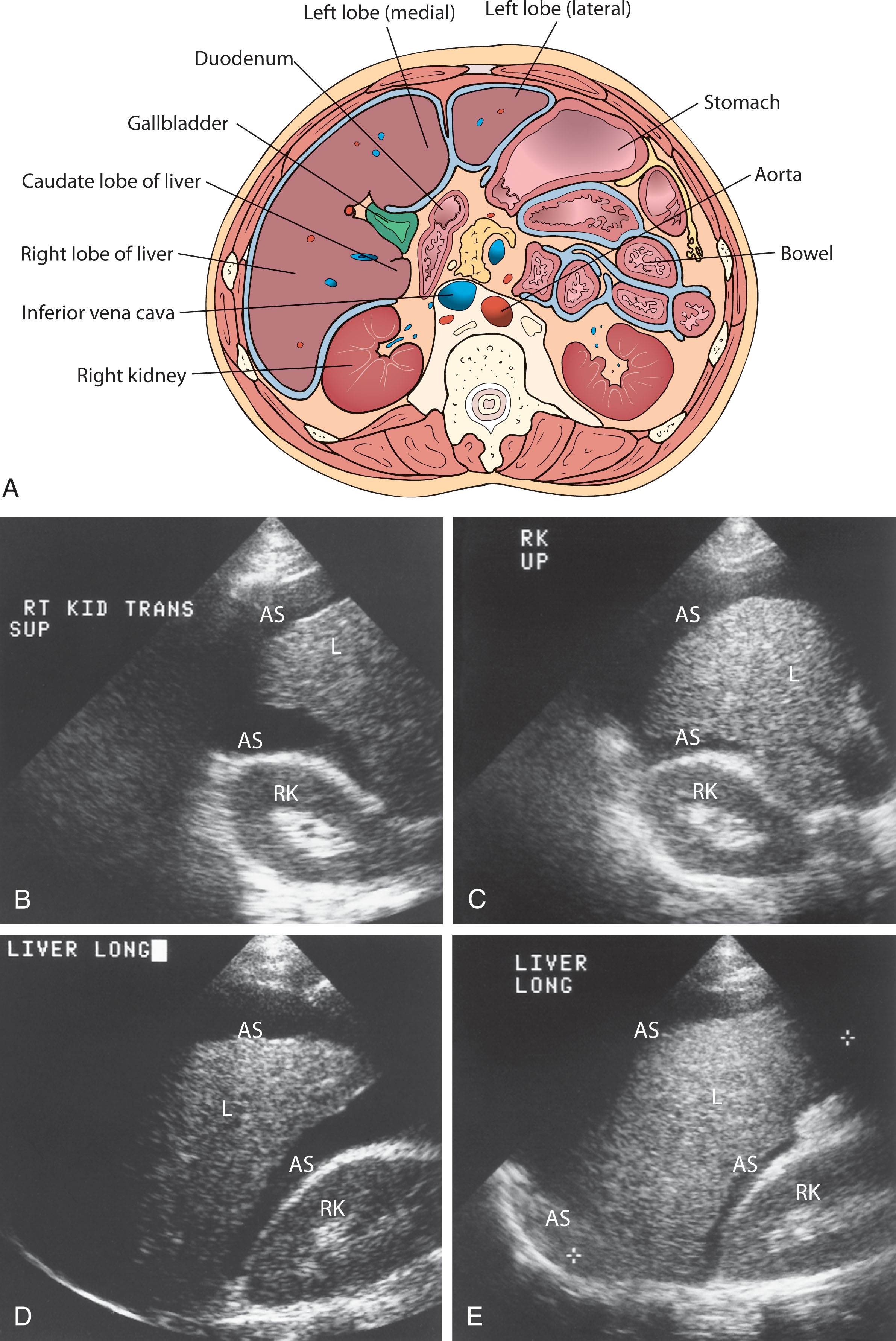
The small bowel loops, sinks, or floats in the surrounding ascitic fluid, depending on relative gas content and amount of fat in the mesentery ( Fig. 14.18 ). The middle portion of the transverse colon usually floats on top of fluid because of its gas content, whereas the ascending portions of the colon, which are fixed retroperitoneally, remain in their normal location with or without gas.
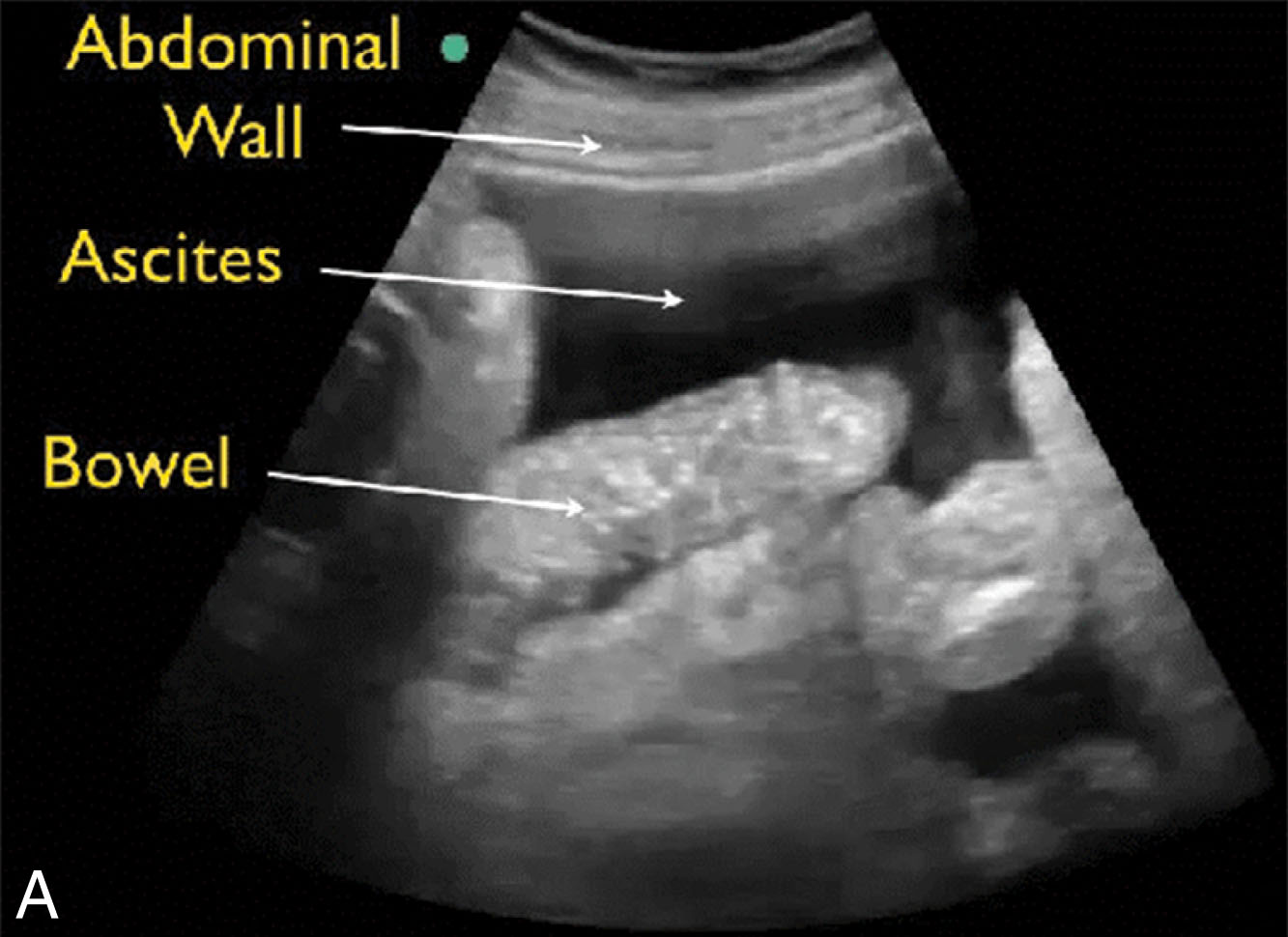
Floating loops of the small bowel, anchored posteriorly by the mesentery and with fluid between the mesenteric folds, have a characteristic anterior convex fan shape or arcuate appearance. An overdistended bladder may mask small quantities of fluid.
The sonographer should look for findings within the ascitic fluid that may suggest an inflammatory or malignant process. In searching for inflammatory or malignant ascites, the sonographer should look for fine or coarse internal echoes; loculation; unusual distribution, matting, or clumping of bowel loops; and thickening of interfaces between the fluid and neighboring structures ( Fig. 14.19 ).
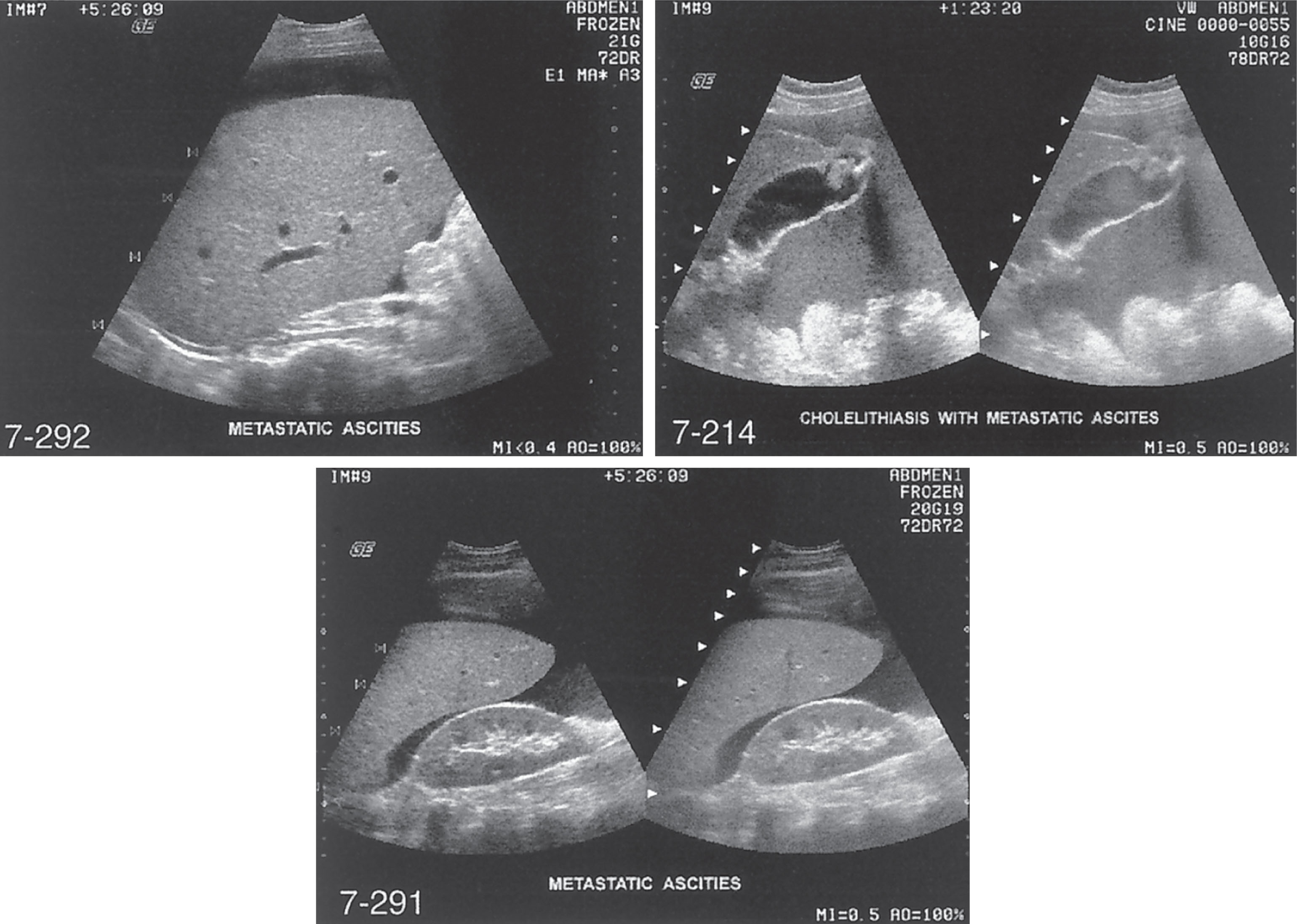
Become a Clinical Tree membership for Full access and enjoy Unlimited articles
If you are a member. Log in here